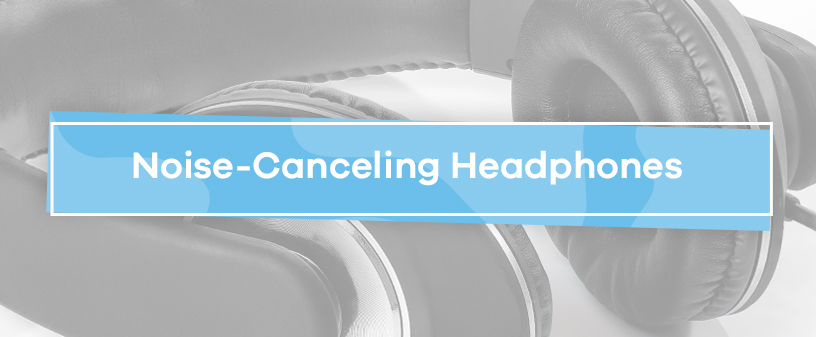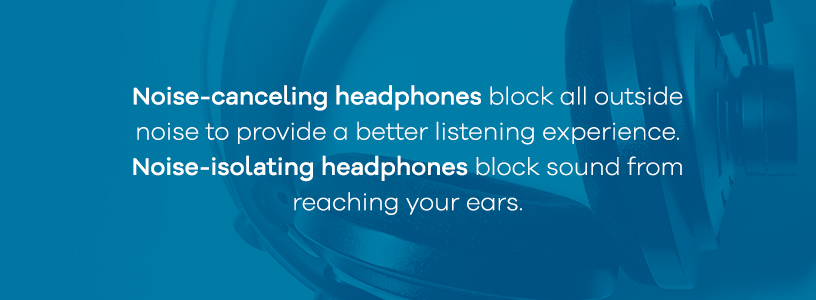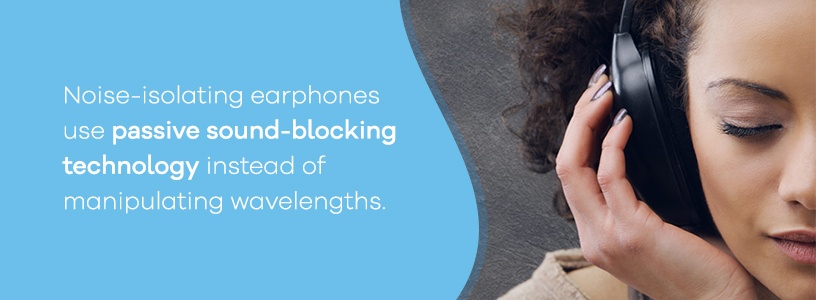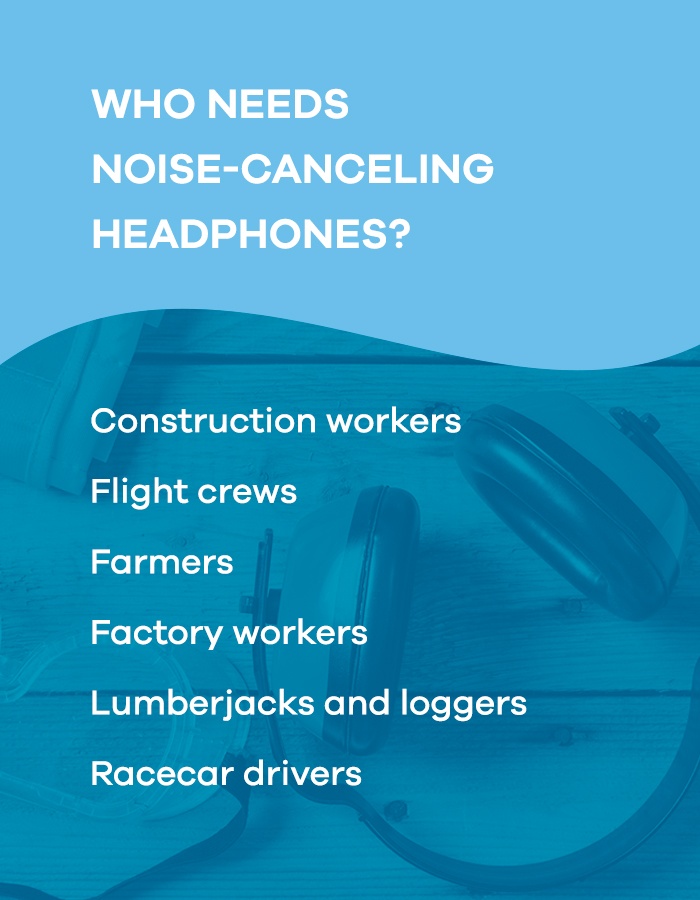
What do you do when you’ve got a million tasks, but colleagues are distracting you with their conversations? Or when you’re trying to sleep, but your neighbor is conducting a heavy metal concert next door? Before you send a shoe flying through their window, think about investing in some noise-canceling headphones.
They’re a portable and easy solution to disruptive noise, allowing you to listen to your favorite tunes in peace or merely use them for noise cancellation. It’s quite fascinating to think that something that transmits sound can also silence it, but that’s what makes this kind of earwear so unique. Though they use incredible technology, you don’t need to be tech-savvy to use a pair of noise-canceling headphones. Install the batteries, flip a switch, and you’ll be on your way to peace and relaxation.
Many types of noise-canceling headphones, earphones and earbuds exist on the audio market. During your search, you’ll likely encounter another kind — called noise-isolating headphones — which you’ll learn more about below. Every brand offers different features, designs and components, but above all, sound quality and noise cancellation matter the most. After all, if you’re buying new earware for a specific task, you want it to achieve what it claims.
Take a look at what makes noise-canceling headphones so useful, how they can work for you and what challenges to expect. Soon you’ll be able to make an educated decision on whether this earwear will make a suitable addition to your audio collection.
Noise-Canceling Headphones vs. Noise-Isolating Headphones
Noise-canceling headphones are somewhat different from what many people think they are. You might think of them as devices that block all outside noise to provide a better listening experience. In essence, that is their job — but they achieve it by generating sound waves. The sound waves drown out ambient noise, leaving you nothing but the music you want to hear. This aspect earns them the name of active noise-canceling headphones (ANC).
Noise-isolating headphones, on the other hand, block sound from reaching your ears by sealing off your canal or entire ear. They essentially muffle the noise instead of actively combating it like noise-canceling headphones do. Also referred to as passive noise-canceling headphones (PNC), they don’t create sound waves, so they don’t require batteries or cords. PNC devices work well with both constant and transient noises, such as the drone of loud machinery or gunshots.
ANC headphones tend to work better in noisy places, like a crowded fast food joint or an airport. They employ active noise cancellation to reduce the surrounding sounds instead of stifling it like PNC headphones do. Both are effective for different reasons and situations, which makes it hard to posit one as wholly better than the other. Some types of earwear contain both ANC and PNC functionality, providing you with the full breadth of noise cancellation.
To some degree, most ANC headphones also contain elements of PNC noise cancellation. An airtight seal is necessary for obstructing external noise and keeping your desired sounds in. Open-back headphones can’t provide this kind of seal because they let in outside noises and leak out whatever you’re listening to. You likely won’t see many ANC or PNC headphones with open backs, if any at all. Open backs can offer a stylish look, but a closed-back pair is necessary for blocking sound.
Noise-Canceling Headphones: How and When They Work Best
Noise-canceling earwear uses a concept called destructive interference to combat external noise. ANC devices contain small microphones that detect the frequency of outside sounds. The headphones send out an anti-noise signal in the form of an inverse wave, which meets the incoming sound wave and cancels it out so it never reaches your ear canal.
Sound wavelengths have peaks, which are high points, and troughs, which are low points. An inverse wave is the opposite of the original sound wave — it’s 180 degrees out of phase. Where the first wavelength possesses peaks, the inverse matches it with troughs, and where it has troughs, the inverse wavelength matches it with peaks. When these opposing waves meet each other, all sound is canceled out, creating a straight line where both waves once were. This phenomenon is how destructive interference occurs.
Noise-isolating earphones use passive sound-blocking technology instead of manipulating wavelengths. They’re often cheaper because they don’t contain any high-tech electronics like ANC earwear. PNC devices often use one or more of these ways to block sound:
- Creating a seal around your ears: The headphones create an external seal around your ears, preventing noise from coming through. Since they cover the entirety of your ear, you’ll likely get higher-quality noise cancellation — this factor also depends on which brand you buy.
- Fitting into your ear: Some earphones possess foam tips that expand inside your ear to create a noise-blocking seal. Many musicians use custom-made in-ears, which are another form of this, but they’re much more expensive. A regular foam tip can give great sound quality if it’s the right size for your ear canal.
- Using sound-absorbing material: Much like the foam tips on earphones, many headphones also have a sound-absorbing medium attached. Memory foam is typically the best at blocking sounds, but rubber is also a popular choice.
Noise-canceling headphones work best with low-frequency sounds, like an airplane engine’s roar or the sound of a distant crowd. Knowing which environments your earwear excels in allows you to get the most out of its capabilities. You won’t need to turn your sound up too high to compensate for outside noise, which protects against the hearing impairment risk regular headphones pose.
Things Noise-Canceling Headphones Can’t Do
Though ANC headphones are great for many occasions, they don’t work for all types of external noise. They don’t filter out high-pitched frequencies like a baby crying or someone blowing a whistle. They also can’t account for sudden, sharp noises, like a firecracker going off. The technology has a buffer zone between interpreting the sound and subsequently reducing it, meaning it can easily miss sounds that only last a few seconds.
If you’re going to a place like a shooting range or Fourth of July festival, noise-isolating headphones work better for protecting your ears. Though they’re passive, they muffle all sounds, leaving no gaps for out-of-range frequencies. A dropped plate won’t sound as startling with PNC earwear, whereas ANC headphones would let the noise slip through. The noise-canceling tech of ANC headphones only works when you switch them on, though some brands also include PNC elements in their earwear for a more comprehensive experience.
For example, if a pair of ANC earphones also has foam tips for an inner-ear seal, these incorporate both active and passive tech. Noise-canceling earware tends to be heavier because of the added material and electronics, but this extra weight isn’t so noticeable that it becomes inconvenient to carry around. Sturdy gadgets often cost more and last longer, so you can be confident that your headphones will persist through many hours of use.
You might find it more comfortable to stick with ANC and PNC earphones that don’t have the in-ear seal. Not everyone wants their earphones deep in their ear canal, even though the risk of damage is little if you keep the volume low. For others, it’s a matter of comfort, with the invasiveness of foam- or rubber-tipped in-ears proving uncomfortable to wear for long periods. Luckily, noise-canceling earwear comes in numerous styles for your safety and comfort.
Determining the best noise-canceling headphones is often a matter of personal choice. Do you prefer in-ear or external? Is battery life a significant point for you? What about comfort? Active noise cancellation excels in many ways, but not every set of earwear will have all the components you desire. Make sure you select a pair according to your main qualifier, whatever that factor might be.
Who Needs Noise-Canceling Headphones?
Anyone can use noise-canceling headphones in various situations. Remember, they don’t cancel every sound — you might have to endure a crying baby or two on your next flight. However, they do an excellent job of muting the frequencies within their range, allowing you to listen to music without background distractions. If you need a snooze in a crowded area, you can slip them on and get some much-needed shut-eye without disturbance. Frequent travelers use these earphones to drown out loud airplane engines.
Many people have jobs that require ear protection to prevent hearing damage. From tractor engines to buzzing chainsaws, there’s no limit to the harmful sounds workers encounter every day. Not having these protective materials puts workers at great risk for hearing loss. These are the people who’d benefit most from noise-canceling headphones, especially the wireless kinds:
- Construction workers
- Flight crews
- Farmers
- Factory workers
- Lumberjacks and loggers
- Racecar drivers
Using a pair of wireless headphones or earphones, like AirPods, removes the need to struggle with lengthy cords while doing manual work. In addition to the hands-free convenience, noise-canceling headphones can reduce some of the risks associated with these high-noise-level jobs. The Centers for Disease Control (CDC) reported that 22 million workers are exposed to hazardous noise each year, with 19% of them sustaining hearing damage. Tinnitus often comes alongside this condition, which can cause anxiety, fatigue and irritability.
Hearing loss can cause other conditions like depression, anxiety and cardiovascular issues. Many of the mental health issues associated with hearing loss stem from the isolation people experience. Not being able to communicate well with others can affect relationships, which diminishes one’s quality of life. A study of participants with moderate to severe hearing loss showed that hearing impairment increased the risk of depression across all age groups. Low- and high-income individuals were particularly affected.
Active noise cancellation is useful for more than preventing health issues, however. Try it out if you want to tune out the noise of your daily subway or bus commute. Slide on a pair of noise-canceling earphones when you head to the gym to get some exercise. Earphones or earbuds can serve well for those who need relative silence to sleep. They can also help promote better concentration, whether you’re a student taking an exam or an athlete prepping before a game.
Disadvantages of Noise-Canceling Headphones
Before you go out and grab a pair of noise-canceling headphones, consider how they might work for you and what you intend to use them for. It’s not recommended to wear them while taking a daily run, walking near traffic or driving. Their noise cancellation qualities are great, but this factor could prove dangerous in some situations. Sometimes it’s better to be alert of your surroundings — even with all the bothersome noises — to stay safe.
As mentioned earlier, ANC headphones don’t catch all sounds. Avoid turning your headphones up too far to block out the noises that make it through. There shouldn’t be many if your environment is reasonably stable, but the ones that do slip by are normal. Although destructive interference is a great soundproofing technique, it still hasn’t reached a level of consistent accuracy. Practice caution the same way you would with regular headphones, and you should be fine.
ANC headphones, earphones and earbuds are more expensive than other devices because of the high tech. They require additional electronics to make active noise cancellation possible, which is why you’ll usually find them at higher price points. Bose and Beats earphones are known for running on the expensive side, but they also provide excellent sound quality and comfort.
Keep your charger close by, because noise-canceling headphones tend to have short battery lives. Analyzing the surroundings and outputting sound waves to match those frequencies requires a lot of power. If you use your headphones often, be prepared to charge them. This aspect won’t be a major issue if you only plan to use them for specific occasions, like taking occasional flights for business trips.
Bluetooth headphones are convenient, but there’s always the chance that your signal can go out and impede your music sessions. The sound quality you receive from a wireless connection might lack in comparison to a wired one, depending on the signal’s stability. Bluetooth devices also emit non-ionizing radiation, which is mostly harmless, though it still poses concerns for some. However, everyone receives some level of radiation from their electronics, which makes Bluetooth somewhat innocuous in the grand scheme of things.
Have You Herd? Check Out More Information About Sound at Soundproof Cow
Sound brings joy and charm to life, whether it’s music, conversation or singing. Here at Soundproof Cow, we know that sometimes you just want some golden silence, whether for better concentration or more restful sleep. Improving sound quality and soundproofing is where we excel, and we aim to provide helpful information on understanding the incredible complexities of noise. To learn more about soundproofing and noise, check out our blog or contact one of our sound experts today!
Learn More About Headphones
Tips for Choosing Noise Cancelling Headphones for Home Office











